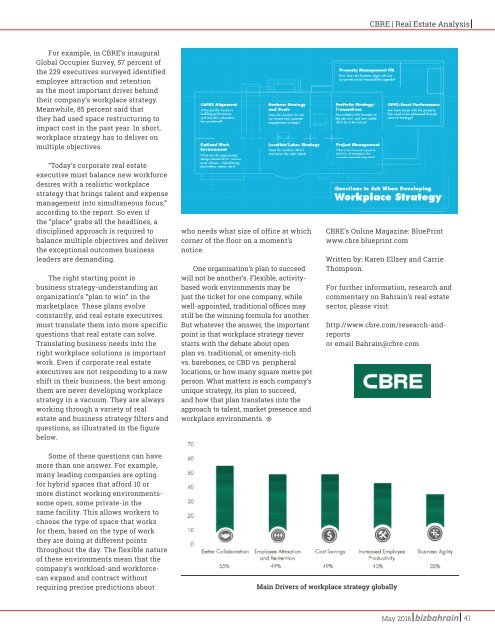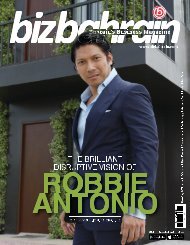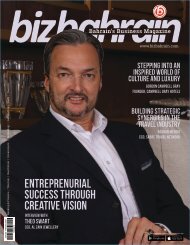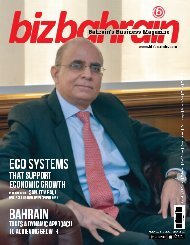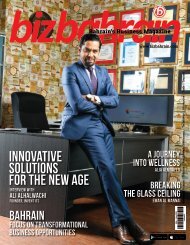BizBahrain April 2016
Create successful ePaper yourself
Turn your PDF publications into a flip-book with our unique Google optimized e-Paper software.
CBRE | Real Estate Analysis<br />
For example, in CBRE’s inaugural<br />
Global Occupier Survey, 57 percent of<br />
the 229 executives surveyed identified<br />
employee attraction and retention<br />
as the most important driver behind<br />
their company’s workplace strategy.<br />
Meanwhile, 85 percent said that<br />
they had used space restructuring to<br />
impact cost in the past year. In short,<br />
workplace strategy has to deliver on<br />
multiple objectives.<br />
“Today’s corporate real estate<br />
executive must balance new workforce<br />
desires with a realistic workplace<br />
strategy that brings talent and expense<br />
management into simultaneous focus,”<br />
according to the report. So even if<br />
the “place” grabs all the headlines, a<br />
disciplined approach is required to<br />
balance multiple objectives and deliver<br />
the exceptional outcomes business<br />
leaders are demanding.<br />
The right starting point is<br />
business strategy-understanding an<br />
organization’s “plan to win” in the<br />
marketplace. These plans evolve<br />
constantly, and real estate executives<br />
must translate them into more specific<br />
questions that real estate can solve.<br />
Translating business needs into the<br />
right workplace solutions is important<br />
work. Even if corporate real estate<br />
executives are not responding to a new<br />
shift in their business, the best among<br />
them are never developing workplace<br />
strategy in a vacuum. They are always<br />
working through a variety of real<br />
estate and business strategy filters and<br />
questions, as illustrated in the figure<br />
below.<br />
who needs what size of office at which<br />
corner of the floor on a moment’s<br />
notice.<br />
One organisation’s plan to succeed<br />
will not be another’s. Flexible, activitybased<br />
work environments may be<br />
just the ticket for one company, while<br />
well-appointed, traditional offices may<br />
still be the winning formula for another.<br />
But whatever the answer, the important<br />
point is that workplace strategy never<br />
starts with the debate about open<br />
plan vs. traditional, or amenity-rich<br />
vs. barebones, or CBD vs. peripheral<br />
locations, or how many square metre per<br />
person. What matters is each company’s<br />
unique strategy, its plan to succeed,<br />
and how that plan translates into the<br />
approach to talent, market presence and<br />
workplace environments.<br />
CBRE’s Online Magazine: BluePrint<br />
www.cbre.blueprint.com<br />
Written by: Karen Ellzey and Carrie<br />
Thompson.<br />
For further information, research and<br />
commentary on Bahrain’s real estate<br />
sector, please visit:<br />
http://www.cbre.com/research-andreports<br />
or email Bahrain@cbre.com<br />
Some of these questions can have<br />
more than one answer. For example,<br />
many leading companies are opting<br />
for hybrid spaces that afford 10 or<br />
more distinct working environmentssome<br />
open, some private-in the<br />
same facility. This allows workers to<br />
choose the type of space that works<br />
for them, based on the type of work<br />
they are doing at different points<br />
throughout the day. The flexible nature<br />
of these environments mean that the<br />
company’s workload-and workforcecan<br />
expand and contract without<br />
requiring precise predictions about<br />
Main Drivers of workplace strategy globally<br />
May <strong>2016</strong><br />
41


